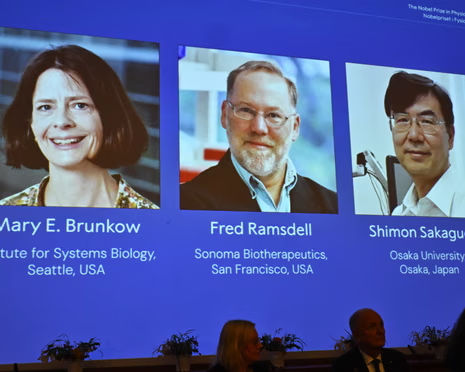Context
- The 2025 Nobel Prize in Physiology or Medicine was awarded to Mary Brunkow, Fred Ramsdell (USA) and Shimon Sakaguchi (Japan).
- They discovered how the immune system is kept in check so it does not attack the body.
- Their work helps develop treatments for autoimmune diseases, cancer, and organ transplants.
What Did They Discover?
- Regulatory T Cells (Tregs):
- A type of immune cell that acts as a “brake” on the immune system.
- Stops the immune system from attacking the body’s own organs.
- Foxp3 Gene:
- A gene that is essential for the formation and function of Tregs.
- Mutations in this gene cause serious autoimmune diseases like IPEX in humans.
- Peripheral Immune Tolerance:
- Mechanism by which Tregs keep mature T cells from attacking healthy tissues.
- Complements central tolerance: Regulatory T cells keeps the self-reactive T cells in check after they leave the thymus (an organ behind the breastbone), ensuring the immune system does not attack the body.
Why It’s Important
- Autoimmune Diseases: Tregs prevent T cells from attacking the body, avoiding diseases like type 1 diabetes or autoimmune thyroid disease.
- Cancer: In tumors, Tregs sometimes protect cancer cells. Treatments may remove or suppress Tregs so the immune system can attack cancer.
- Organ Transplants: Tregs help the body accept transplanted organs by preventing immune rejection.
How Regulatory T Cells Work
- T cells are like soldiers; they attack invaders (bacteria, viruses).
- Some T cells can accidentally attack the body.
- Regulatory T cells act like commanders, telling these T cells: “Don’t attack our own body.”
- This balance prevents autoimmune diseases while still fighting infections.
Key Examples from Research
- Sakaguchi (Japan) studied mice without Tregs – The mice developed autoimmune diseases.
- Brunkow and Ramsdell (USA) identified Foxp3 gene – Explained why humans with mutations get autoimmune diseases.
- Today, over 200 studies are exploring Tregs for treatments in cancer, autoimmune conditions, and organ transplants.
Challenges and Way Forward
| Challenges | Way Forward |
| Balancing Treg activity: Too many Tregs can suppress immunity, too few can trigger auto-immune diseases. | Develop therapies that modulate Tregs precisely, increasing or decreasing them only where needed. |
| Targeted delivery: Treg-based interventions may affect the whole body instead of specific tissues/organs. | Use localized, tissue-specific, or temporary Treg modulation techniques to minimize systemic side effects. |
| Safety and long-term effects: Manipulating Tregs is new, and long-term outcomes in humans are uncertain. | Conduct extensive preclinical and clinical trials to ensure therapies are safe, effective, and sustainable over time. |
| Individual variation: Genetic differences (e.g., Foxp3 mutations) influence Treg function and treatment responses. | Implement precision medicine approaches by tailoring therapies to individual genetic and immunological profiles. |
| Integration with existing treatments: Combining Treg modulation with conventional therapies can be complex. | Research optimal combination protocols, monitor biomarkers, and personalize treatment plans to improve efficacy. |
Conclusion
The discovery of regulatory T cells and the Foxp3 gene has revealed how the immune system avoids attacking the body, preventing autoimmunity. This breakthrough opens new avenues for treating cancer, autoimmune diseases, and improving organ transplantation. Despite challenges like precise modulation and safety, ongoing research promises innovative therapies, highlighting how fundamental science drives transformative advances in medicine.
| Ensure IAS Mains Question Q. Discuss the significance of the discovery of regulatory T cells and the Foxp3 gene in understanding the immune system. How can this knowledge be applied in treating autoimmune diseases, cancer, and improving organ transplantation? (250 words) |
| Ensure IAS Prelims Question Q. Which of the following statements about regulatory T cells (Tregs) is incorrect? a) They prevent the immune system from attacking the body’s own tissues. b) They are responsible for producing all antibodies in the immune system. c) Mutations in the Foxp3 gene can lead to autoimmune disorders in humans. d) They can be targeted to enhance immune response against tumors. Answer: b) They are responsible for producing all antibodies in the immune system. Explanation: 1. Regulatory T cells act as a “brake” on the immune system, preventing T cells from attacking the body’s own tissues. This is essential for avoiding autoimmune diseases. 2. The Foxp3 gene is critical for the development and function of Tregs. Mutations in this gene can disrupt Treg function, leading to severe autoimmune disorders such as IPEX syndrome. 3. In cancer therapy, Tregs can sometimes suppress anti-tumor immunity. Targeting or modulating Tregs can enhance the immune response against tumors, making them a potential focus for immunotherapy. Option (a), (c) and (d) are incorrect as they explain about Tregs accurately and the question asks for the incorrect statement. Option (b) is the answer: Tregs do not produce antibodies. Antibody production is the role of B cells. Tregs regulate immune responses but do not secrete antibodies. |
Also Read | |
| UPSC Foundation Course | UPSC Daily Current Affairs |
| UPSC Monthly Magazine | CSAT Foundation Course |
| Free MCQs for UPSC Prelims | UPSC Test Series |
| ENSURE IAS NOTES | Our Booklist |





